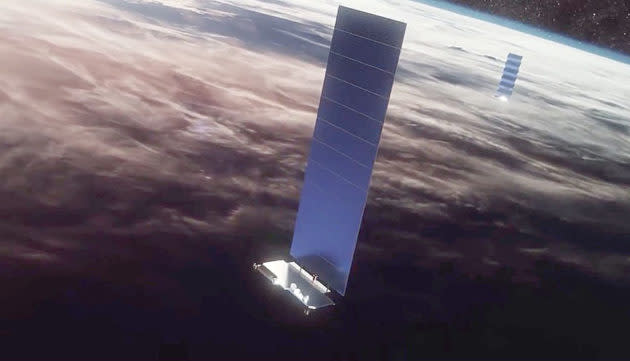SpaceX reports milestone for Starlink satellite links — and sparks a debate

In the wake of last month’s launch of 60 Starlink broadband data satellites, SpaceX says all but three of them are in communication with the company’s network of ground stations, including the satellite operation’s home base in Redmond, Wash.
In an emailed update, SpaceX said Starlink is ready to go into a testing phase that involves streaming videos and playing video games via satellite.
Forty-five of the satellites have used their onboard krypton ion thrusters to reach their intended 550-kilometer (342-mile) altitude. Five satellites are in the process of raising their altitude from the 440-kilometer-high (273-mile-high) orbits into which they were launched, and five more are undergoing checkouts in preparation for raising their orbits, SpaceX said.
Two of the satellites are in communication but will be “intentionally deorbited to simulate an end-of-life disposal,” SpaceX said in today’s update. The remaining three Starlink satellites were initially in contact but are no longer in service, SpaceX said. They’ll eventually fall out of orbit and burn up in the atmosphere.
“Now that the majority of the satellites have reached their operational altitude, SpaceX will begin using the constellation to start transmitting broadband signals, testing the latency and capacity by streaming videos and playing some high-bandwidth video games using gateways throughout North America,” SpaceX said.
Those gateways include an installation in Redmond, where SpaceX’s satellite development team is based. According to filings with the Federal Communications Commission, the other gateways are in Hawthorne, Calif., where SpaceX is headquartered; North Bend, Wash.; Conrad, Mont.; Merrillan, Wis.; and Greenville, Pa. There’s also a telemetry and tracking station in Brewster, Wash.
SpaceX said “Starlink is now the first NGSO [non-geosynchronous satellite orbit] system to operate in the Ku-band and communicate with U.S. ground stations, demonstrating the system’s potential to provide fast, reliable internet to populations around the world.”
That statement isn’t intended merely as a marketing boast: In documents filed earlier this month with the Federal Communications Commission, SpaceX says its “first to operate” status with the FCC means it can “select its frequencies first” if there’s a conflict with other satellite telecommunication networks in low Earth orbit.
SpaceX’s claim on that score has set off a flurry of regulatory filings from its rivals in the market for satellite broadband services, including the international OneWeb consortium and Canada’s biggest satellite operator, Telesat.
OneWeb, for example, launched the first six Ku-band satellites for its broadband satellite constellation back in February. Kepler Communications, a Canadian venture that’s focusing on satellite services for the Internet of Things, has launched two Ku-band satellites so far — including one that went up on an Indian rocket last October.
In one of this month’s filings, OneWeb charged that SpaceX was being “irresponsible” by going ahead with a Ku-band system under conditions that would interfere with OneWeb’s previously launched satellites. But SpaceX shrugged off OneWeb’s objections, as well as Kepler’s. It said neither OneWeb nor Kepler qualified for the FCC’s first-choice status because their ground stations weren’t in the U.S.
Telesat, meanwhile, told the FCC that SpaceX seemed to be misreading the rules about getting its first choice for operating frequencies. This week, a lawyer for SpaceX filed a reply, basically seeking to find out what Telesat meant. On Thursday, Telesat’s lawyers basically said, “Stay tuned.”
The exchange of FCC filings illustrates how tangled the regulatory environment for satellite internet broadband services can get. And things could get even more tangled if additional players including Amazon and Boeing join the fray.
Here’s the full text of today’s statement from SpaceX:
“Just a little over a month after a successful Falcon 9 launch, Starlink is now the first NGSO system to operate in the Ku-band and communicate with U.S. ground stations, demonstrating the system’s potential to provide fast, reliable internet to populations around the world.
“57 Starlink satellites are communicating with SpaceX’s Earth stations using their broadband phased array antennas. 45 Starlink satellites have reached their operational altitude using their onboard propulsion systems, five additional satellites continue their orbit raise, as five others are going through checkouts prior to completing their orbit raise. Two satellites are being intentionally deorbited to simulate an end of life disposal. Three satellites which initially communicated with the ground but are no longer in service, will passively deorbit. Due to their design and low orbital position, all five deorbiting satellites will disintegrate once they enter Earth’s atmosphere in support of SpaceX’s commitment to a clean space environment.
“SpaceX implemented slight variations across the 60 satellites in order to maximize operational capability across the fleet. While we are pleased with the performance of the satellites so far, SpaceX will continue to push the operational capabilities of the satellites to inform future iterations. And, now that the majority of the satellites have reached their operational altitude, SpaceX will begin using the constellation to start transmitting broadband signals, testing the latency and capacity by streaming videos and playing some high bandwidth video games using gateways throughout North America.”
More from GeekWire:
FCC approves SpaceX’s revised Starlink satellite plan; first wave gets set for liftoff
SpaceX’s Falcon 9 rocket deals out a deck of 60 Starlink internet satellites
FCC OKs SpaceX’s plan for 7,500 satellites in very low Earth orbit (and its rivals’ plans)
Report: SpaceX raising $500M to get Starlink satellite service off the ground
